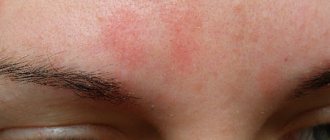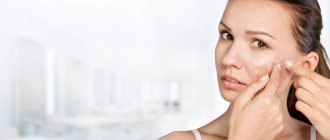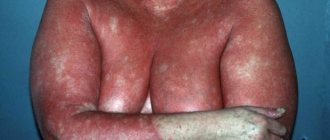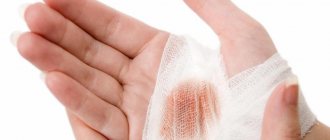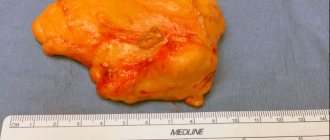Causes and types of dermatitis
The disease occurs when the protective function of the skin is weakened due to prolonged exposure to aggressive substances or decreased immunity. The cause of the pathology can be the following factors:
- mechanical irritation, friction, compression of the skin;
- thermal burn or frostbite, ionizing, UV and other radiation, electric current;
- contact with chemicals contained in skin care products, household chemicals, decorative cosmetics, as well as salts of heavy metals, acids or alkalis, medications for external use;
- allergic reaction to plant pollen, animal hair, food, medications;
- infection with viruses, bacteria or fungi;
- taking antibiotics, sulfonamides, novocaine-containing drugs;
- systemic diseases, hormonal disorders, hypovitaminosis, pathology of the digestive organs, liver, disorders of carbohydrate and fat metabolism, helminthic infestation, influenza and ARVI.
According to etiological factors, there are:
- Perioral dermatitis. It occurs due to the abuse of cosmetics, improper local use of hormonal drugs, the use of medicated fluoride-containing toothpastes, hypovitaminosis A and E. In childhood, it appears with increased salivation and during teething.
- Atopic dermatitis. Occurs mainly in children prone to allergic reactions and has a hereditary predisposition. Irritants may include foods, allergens of plant or animal origin, dust mites, Staphylococcus aureus enterotoxins, and mold fungi. Rashes in a child of the first years of life are localized mainly on the face and extensor surfaces of the limbs, and at an older age and in adults, dermatitis appears on the elbows and popliteal folds.
- Contact allergic dermatitis. Appears when the skin comes into contact with substances to which the immune system is sensitized. May develop at lightning speed and be accompanied by anaphylactic shock.
- Actinic dermatitis. An allergic reaction to ultraviolet radiation, also known as sun allergy.
- Drug dermatitis. Occurs as a reaction to the use of medications (iodine, brilliant green).
- Seborrheic dermatitis. The cause of the disease is fungi of the genus Malassezia. Exacerbation occurs in hot and humid weather, with stress, hormonal, immune and neuroendocrine disorders, when the activity of the sebaceous glands increases. In places where they accumulate, the symptoms are more pronounced. Most often, seborrheic dermatitis affects the scalp, face, and upper third of the body.
- Infectious dermatitis. It develops when the skin is damaged by pathogenic bacteria, viruses, and fungi.
- Dry dermatitis. Occurs in people with sensitive skin during the cold season.
- Lichen planus. It is characterized by the appearance of red or pink plaques and intense itching. May affect nail plates.
- Toxidermy. A disease of an allergic nature, in which an irritant enters the body through the blood, respiratory system or oral cavity. There are medicinal, food and professional forms.
Why does facial skin peel?
Peeling itself is the appearance of small dry “scales” on the skin (usually on the cheeks, nose or chin). Sometimes, due to excessive dryness, this process can be accompanied by unpleasant itching. One of the main reasons why the skin on the face peels is damage to the protective barrier - the so-called hydrolipid mantle of the skin.
If the hydrolipidic barrier ceases to fully perform its functions, the structure of the stratum corneum suffers, the connection between cells in the upper layers of the epidermis is disrupted, moisture begins to evaporate too quickly... And, as a result, the skin can become dehydrated and flaky. This process can be triggered by both external and internal factors:
- Aggressive environmental influences: these can be either difficult climatic and weather conditions (frost, wind, hot sun) or household factors (dry indoor air, bad water).
- Incorrect skin care: incorrect selection of cosmetics according to skin type, excessive use of scrubs and peels, cleansing the skin “to the point of squeaking,” insufficient hydration.
- Vitamin deficiency: vitamins E, A, C and group B are especially important for the skin. It is better to determine their possible deficiency using tests and choose the optimal way to replenish the vitamin and mineral deficiency with the help of a dermatologist.
- Incorrect drinking and eating regimens: insufficient water consumption, excessive reliance on fast carbohydrates and other dietary errors.
- Various skin diseases: in this case, it is important to get a face-to-face consultation with a dermatologist to establish the causes of peeling and decide on treatment tactics.
Why does the skin on a woman's face peel?
In addition to the factors already listed, in women, flaking of the skin on the face can occur against the background of various hormonal changes (in particular, during pregnancy, during menopause), or it can be one of the signs of premature aging of the skin.
Peeling skin on the face in men
For men, an additional “provocateur” for peeling can be shaving too often, an incorrectly selected razor or simply an old razor, unsuitable shaving product, active use of alcohol-containing products and the habit of washing with very hot water.
Symptoms of dermatitis
The main manifestations of the disease are redness and increased pigmentation of the skin, the formation of focal rashes, thickening, swelling, itching of varying intensity in the affected areas, burning, pain and other symptoms of tissue irritation. In acute form, the inflammation process occurs in stages:
- In the erythematous stage, redness, itching and burning are moderate, and there is slight swelling.
- The bullous stage is more severe. Blistering rashes appear on the affected areas, and the itching becomes intense. When scratching, first weeping wounds are formed, which are subsequently covered with a dense crust.
- The last necrotic stage is characterized by the formation of scabs and ulcers at the site of scratching. The rash covers increasingly larger areas. Old injuries gradually heal without consequences or with the formation of scars.
With chronic dermatitis, the symptoms are less pronounced, the disease remains in the first stage for a long time.
As a result of prolonged inflammation, the skin becomes rough, dense scales and a white coating resembling a dry callus appear on it. In severe cases, the affected areas atrophy and turn pale. The clinical picture depends on the form of the disease. In the case of its allergic nature, the itching and burning are more intense, the redness is more pronounced than with contact dermatitis. Affected skin areas can spread throughout the body, regardless of where the irritant is applied.
Atopic dermatitis is characterized by intense itching. As it progresses, blisters filled with cloudy liquid form in hyperemic areas of the body. In the last stages of the disease, severe dryness and pallor of the skin predominate.
In the oral form of dermatitis, the first rashes are localized on the face - in the area of the cheeks, bridge of the nose, chin, and near the mouth. This is characterized by the presence of a rim of healthy skin around the red border of the lips. Itching, flaking, dryness and a feeling of tightness are noted.
Contact dermatitis is characterized by local redness of the skin in places of contact with the irritant, swelling, a rash in the form of blisters, the appearance of cracks, dryness and weeping. There is itching of varying severity, burning and pain in the inflamed areas.
Eczema is manifested by a variety of rashes, severe itching, dryness and flaking of the skin, cracks, redness, swelling or weeping.
Toxidermia is characterized by urticaria, the appearance of red and pigmented spots on the skin, oozing, swelling of the face and limbs, peeling of large scales, and acne.
The generalized form can occur as lichen planus, allergic vasculitis, lupus erythematosus.
CeraVe creams and lotions for peeling skin on the face
One of the most common questions that arises among those who are faced with a similar problem: what product to choose if the skin on the face is peeling? Intuitively, many people consider severe flaking to be a sign of dry skin and prefer oily and nourishing products. However, this may not be entirely correct.
Care products for flaking skin on the face should, first of all, help restore the protective functions of the skin and strengthen its hydrolipid barrier. In particular, some CeraVe creams and lotions with ceramides have such properties. Using their example, we will analyze what results can be expected from care when the skin on the face is peeling.
SA CeraVe Softening Cleansing Gel
Why: delicately and carefully cleanses rough, dry and uneven skin
What's in it:
- Ceramides are lipids that are part of the skin's protective barrier; they help form the hydrolipid mantle;
- Salicylic acid – helps exfoliate dead skin particles and actively renew it;
- Hyaluronic acid – attracts moisture and maintains skin hydration.
What result can you expect: gentle cleansing that does not violate the skin’s protective barrier, but helps strengthen it.
SA Softening Cleansing Gel
For dry, rough and uneven skin
Gently cleanses and exfoliates dry, uneven skin without damaging its protective barrier.
236 ml
More details
Moisturizing cream for dry and very dry skin CeraVe
Why: actively moisturizes dry and very dry skin, strengthens its protective functions.
What's in it:
Ceramides and phytosphingosine are lipids and phospholipids that help restore and maintain the protective functions of the skin and prevent moisture loss.
Glycerin - helps restore skin barrier functions, helps fight dryness, softens the skin and protects it from aggressive environmental influences.
Hyaluronic acid - saturates the skin with moisture, together with glycerin helps maintain the hydration and functioning of the hydrolipid mantle and the barrier functions of the skin.
What result can you expect: long-lasting hydration of the skin throughout the day, which helps to resist the aggressive effects of the external environment and strengthens the protective functions of the skin.
Moisturizing cream
For dry to very dry skin of the face and body
Provides long-lasting hydration throughout the day, restoring and strengthening the protective skin barrier.
More details
CeraVe Moisturizing Facial Lotion for Normal to Dry Skin
Why: intensively moisturizes and soothes the skin.
What's in it:
Ceramides, phytosphingosine and cholesterol are the most important components of the hydrolipid mantle, which help strengthen the skin's protective barrier.
Niacinamide is a B vitamin that helps soothe the skin and also promotes the synthesis of natural ceramides.
Tocopherol is an active antioxidant that helps reduce skin susceptibility to aggressive external influences.
What result can you expect: intensive skin hydration and protection from the effects of negative environmental influences.
Moisturizing facial lotion
For normal to dry skin
Moisturizes the skin throughout the day, helps restore and strengthen the skin's protective barrier.
52 ml
More details
Complications of dermatitis
Any form of dermatitis accompanied by skin damage can be complicated by infection.
In the chronic course of the disease, thinning of the skin and the appearance of small dilated vessels - telangiectasia - are possible. With prolonged atopic dermatitis, a child may develop asthma and allergic rhinitis. Among the adverse consequences of the seborrheic form of the disease are acne with the formation of visible skin defects, abscess, and baldness. The most serious are considered generalized complications such as Quincke's edema, Lyell's syndrome or Stevens-Johnson syndrome.
Diagnosis of dermatitis
The diagnosis is made based on the existing symptoms, the results of an external examination of the patient’s skin and mucous membranes, visual assessment and localization of pathological changes.
An anamnesis of the disease must be studied in order to establish the possible cause of dermatitis and its genetic cause. Laboratory diagnosis of dermatitis includes the following studies:
- General clinical blood test. During an allergic reaction, an increase in the number of eosinophils is observed, and an accelerated ESR indicates inflammation.
- Blood chemistry. Includes determination of the concentration of AST, ALT, total bilirubin, triglycerides, cholesterol, total protein.
- Determination of the level of immunoglobulins in blood serum, antibodies to food, household antigens, antigens of plant, animal and chemical origin.
If necessary, it is possible to conduct a histological examination of the biomaterial obtained through skin biopsy. Genetic blood testing helps determine hereditary predisposition to the development of atopic disease. In the presence of a purulent process or severe inflammation, a microscopic and bacteriological examination of the smear is prescribed in order to clarify the causative agent. Additionally, for dermatitis, tests are carried out for giardiasis and other forms of intestinal parasites, and the organs of the digestive tract are examined.
Endocrine diseases. Self-diagnosis
Murzaeva Irina Yurievna
Endocrinologist, Preventive Medicine Doctor
September 3, 2017
Unfortunately, the practice of annual medical examinations and mass disease prevention in kindergartens and schools are gradually becoming a thing of the past. Remember, they used to give fish oil, iodine preparations - Antisturmin, etc. for breakfast. Health magazine taught people all over the country to self-diagnose breast tumors, provide first aid to themselves and others... Times change, not always for the better, but this is a separate topic. The motto of “our intertime” is help yourself.
Today I will tell you how to suspect one or another endocrine disease when examining your own body . Just suspect and consult a doctor, and not start treating yourself!
Information about this mysterious photo is below. 
So let's start with SKIN .
It occupies a huge surface area of the body, performs many functions and is the first to respond to changes in the body.
Dryness, peeling (scales) of the skin of the face, torso, arms and legs
- often this is a sign of hypothyroidism (reduced thyroid function), and this is most clearly visible in the dryness and flaking of the elbows, sometimes as a “flour” type, dry elbow with a white coating;
- It can also be a sign of severe dehydration. Take a closer look to see if you have any new wrinkles;
- allergies can always be distinguished - peeling with bright pinpoint rashes and itching;
- peeling and cracking of the fingers - often this is a manifestation of anemia or liver pathology (fatty hepatosis and other diseases);
- But if your feet are dry and flaky, get checked for fungal diseases and diabetes.
What a seemingly insignificant symptom, but so much information.
Acantosis nigricans - I can only write here in Latin, the symptom is extremely important, this is the appearance of dark-colored foci of pigmentation (similar to a tan) in places where clothing rubs: neck, armpits, groin area, under the breasts, on the elbows, a sign of incipient diabetes, or prediabetes. This symptom is also called a sign of insulin resistance (the body’s metabolism of the hormone insulin, which is responsible for the absorption of sugar from food, is disrupted). The symptom is terrible, it also happens in children, and is often a sign of hereditary insulin resistance.
You need to go to an endocrinologist as soon as possible!
Pigmentation is a very broad concept; spots come in different colors and sizes.
A bronze tint of the skin over the entire surface of the body, especially increasing in winter, is a sign of another formidable disease - adrenal insufficiency. It is urgent to donate cortisol and ACTH blood.
Pigmentation with uneven edges, a light brown tint, that appears after childbirth - chloasma, this is a manifestation of a violation of skin nutrition. It is possible that you had iron deficiency anemia during pregnancy; you need to check again to see if there is an iron deficiency. If there are disturbances in the body’s oxidative-antioxidant system (primitively, “a lot of harmful radicals” have accumulated in the body and they damage the skin), it is necessary to resolve the issue of taking alpha-lipoic acid and check liver function.
Pigmentation in women 55+, 60+ is finely dotted, bright brown, which everyone perceives as a tan - a sign of skin aging and a deficiency of sex hormones. It also doesn’t hurt to check for anemia.
Bright brown pigmentation of the lower eyelid can also be a sign of anemia, or, less commonly, adrenal dysfunction.
Pigmentation expressed only on the anterior surface of the skin of the legs (without itching) is often a sign of a “hidden increase” in blood sugar - you need to look for diabetes.
The appearance of bright red spots on the body, often small 2-3 mm - “ruby spots”, a sign of liver dysfunction (fatty hepatosis and other diseases).
Pappules, not acne, on the eyelids, face - they are called xanthomas, these are small wen, it is clear that this is a disorder of fat metabolism and the lipid profile must be checked. They happen even in 7-8 year old children - no one has abolished hereditary dyslipidemia and the child may have cholesterol of 8.0 mmol/l.
INCREASED SWEATING (HYPERHIDROSIS) is a very common symptom.
If the sweating is local - only the hands or only the legs, or only the armpits, this is unlikely to be an endocrine pathology - it is often a dysfunction of the sympathetic nervous system. But sweating all over the body can be a symptom of diffuse toxic goiter, and increased sweating of the scalp is a symptom of vitamin D hypovitaminosis (like rickets).
HAIR
Thinning and hair loss are often the first sign of anemia! This may also be a symptom of hypothyroidism, calcium metabolism disorders and disturbances of other microelements important for hair condition: zinc, selenium, manganese and copper. Hair loss can be a sign of progesterone deficiency (due to cycle disruption in women). And even a decrease in progesterone in men can result in hair loss.
Early gray hair is often the first sign... ANEMIA, sometimes copper deficiency.
Thinning and hair loss at the age of 50+, 60+ is often a deficiency of sex hormones, rather than their excess (previously, in women, this symptom was associated with excess androgens).
But male pattern hair loss in young women, this is hereditary androgenetic alopecia, is often the first symptom of the onset of PCOS (polycystic ovary syndrome).
In men with androgenetic alopecia, everything is simpler - it is often a deficiency of testosterone, and not its excess, as previously thought.
Hair loss in children! – this should be a paradox (a growing child should not have alopecia). This is either a sign of rickets (after 1 year of life, rickets is called osteomalacia), or anemia, or, most often, it is insulin resistance! It is extremely rare, but it happens that it is associated with an autoimmune disease.
Patchy hair loss is a sign of extreme stress, both in children and adults!
In teenage girls, hair loss may be associated with ovarian dysfunction and progesterone deficiency.
Loss of the outer third of the eyebrows is often a sign of iodine deficiency (classic) and hypothyroidism.
Sometimes patients complain about changes in the hair structure, “they were curly and began to straighten sharply” - these are not miracles, this is a violation of the exchange of sex hormones, especially if the woman has been taking COCs (contraceptives) for a long time. In this case, her pituitary gland and ovaries fell asleep, and a deficiency of estrogen and progesterone developed.
And now the most interesting thing is - we take an ordinary centimeter in our hands and begin to measure, what?
- Waist circumference Ladies, a waist circumference of more than 80 cm is incipient obesity. For men – more than 92 cm, “hello obesity.” Children have individual tables for their waist circumference according to height and age; I will not give them here. For the same purpose, pinch yourself under the shoulder blade :D:) If the skin-fat fold in this area is more than 2 cm! This is a sure step towards obesity! When visiting a doctor, it is better to measure the skin-fat fold with a calipermeter; this is a more accurate measurement method.
- Wrist circumference Who said you have a “big bone”? Ladies, wrist circumference: 16-17 cm is the norm. “Thin bone” is less than 16 cm, “large” is more than 17 cm. In men, the norm is 16-20 cm, respectively. But in men it is better not to measure the circumference of the wrist; it is better to determine body composition using bioimpedanceometry - many men have a well-developed or inflated muscle group and it is necessary to look at the real proportions of muscle/fat tissue.
- You can measure the proportion, the ratio of waist circumference / hip circumference. WC/BV more than 0.85 in women and more than 1.0 in men is visceral obesity - obesity of internal organs, indicates the risk of developing metabolic syndrome (obesity with metabolic disorders of both fats and carbohydrates).
You can put the centimeter aside for now;)
LOOKING IN THE MIRROR
Strengthening of nasolabial folds and the appearance of wrinkles outstripping the rate of age-related changes is a sign of a deficiency of sex hormones; it would be good to check with a gynecologist-endocrinologist.
Drooping, swollen upper eyelid - monitor your blood pressure and check your kidneys. In more rare cases, this is a manifestation of hypothyroidism. Swelling and at the same time a change in the shape of the eyes (a look of extreme surprise) is a symptom of dysfunction of the thyroid gland (diffuse - toxic goiter).
Sagging of the oval of the face and the appearance of a double chin are a manifestation of a deficiency of sex hormones and the beginning of a decrease in growth hormone.
NAILS
Ribbed nails, thin and brittle - again everything is primitive, we check for anemia and calcium metabolism disorders. But the flattening and whitening of the nail plates - we check the heart muscle.
So, if all the deficiencies in the body have been eliminated :), but the nails are still thin, the skin is dry and the hair is thinning - it’s time to check the Omega-3 index in the blood, yes, it is the deficiency of healthy omega-3 fats in the body that can be the cause of ongoing skin problems , nails and hair.
The dose of Omega-3 taken will be different for everyone, minimum 2000 mg per day and higher! It is necessary to monitor the omega-3 blood index. That’s why I published this stunning photo of an Eskimo woman at the beginning of the article - gorgeous skin and facial proportions, which means there are no problems with omega-3 and sex hormones:
Finally…..
I really want to talk about the famous “bones” on women’s legs
“they say, I walked around in heels all my youth”;). A woman should walk in heels all her life, and “bunions at the base of the big toe” are a sign of a severe violation of vitamin D metabolism! And, accordingly, weakness of the foot muscles (sarcopenia), so “the bones spread in different directions”, there are no growths there! Get tested for vitamin D deficiency and treat hypovitaminosis D as soon as possible and in large doses.
To be continued…….
Treatment of dermatitis
Treatment tactics for dermatitis depend on the cause and form of the disease. General recommendations for the patient include:
- establishing a work and rest schedule, sleeping at least 8 hours a day;
- a diet based on limiting fried, spicy and canned foods, possible food allergens;
- carrying out hygiene procedures in warm water (not higher than 34°C);
- eliminating stress and nervous overload.
In case of severe itching, accompanied by sleep disturbances and neurological disorders, the prescription of sedatives, mainly of herbal origin, is indicated.
It is important to stop contact of irritants with the skin or internal environment of the body as soon as possible. To achieve this, cleansing and general detoxification measures are carried out:
- in case of chemical exposure to the skin, it is thoroughly washed and a bandage is applied with a neutralizing substance - alkali for an acid burn or an acid for an alkali burn;
- for perioral, drug-induced and allergic dermatitis, after washing the skin, enterosorbents, a hypoallergenic diet, and in severe cases, intravenous infusions of special solutions are prescribed;
- Treatment of parasitic infestation is carried out using anthelmintic drugs.
Also in the treatment of dermatitis, antihistamines, antibiotics and antifungals are used both locally, on the skin, and systemically.
Wet areas of the skin can be treated with antiseptic solutions and herbal infusions that have a drying effect. Hormonal ointments for dermatitis have an anti-inflammatory effect. Severe itching and pain, as well as a large area of damage and the appearance of areas of tissue necrosis, are indications for urgent hospitalization of the patient. In case of severe disease with damage to more than 20% of the skin, a course of prednisolone tablets is recommended. In such situations, treatment may be supplemented with immunosuppressive drugs.
Author:
Pugonina Tatyana Alekseevna, Therapist
What else to do if your face is peeling
How else can you get rid of peeling skin on your face? In addition to carefully selecting products that help moisturize the skin and strengthen its protective barrier, it is important to follow the following principles of care:
- Try to wash your face with cool (not hot) water and use gentle cleansers that are suitable for your skin type.
- Maintain a drinking regime (it is better to give preference to clean water), be attentive to your diet (you should avoid fast carbohydrates, fast food, and include foods rich in vitamins, minerals and polyunsaturated fatty acids in your diet).
- During periods of active peeling of the skin on the face, it is better to refrain from multi-layered makeup, intensive cleansing procedures, and the use of aggressive scrubs and peels.
- It is important to protect sensitive skin that is prone to flaking areas not only from the sun, but also from cold, wind and sudden temperature changes, especially in autumn and winter.
These simple rules will tell you how to remove peeling on your face at home and help prevent its new manifestations.
